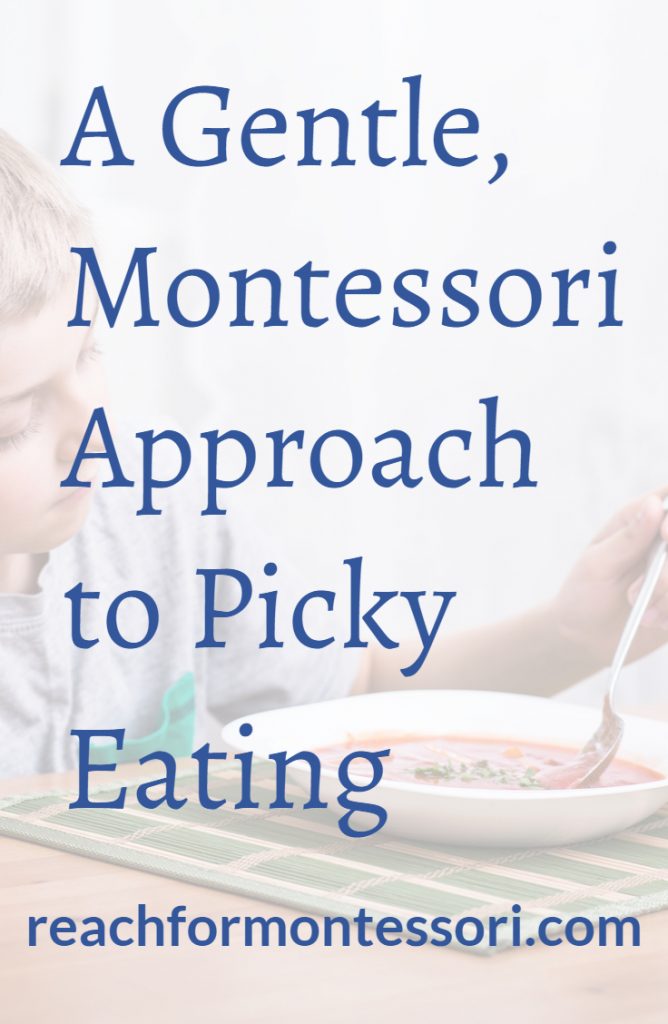Ah, everyone’s favorite parenting struggle…a child that won’t eat what you serve. If you are have trouble getting your kid to eat something other than peanut butter sandwiches and chicken nuggets, I am here to tell you there are ways to get picky eaters to eat healthy!
And in a gentle, Montessori-inspired way.
And you don’t have to make a separate meal for your picky eater.
From the time you begin the weaning process, you might notice your child has a preference for/against certain foods. This can be true, whether you chose to start with purees or baby-led weaning.
How can I get my picky eater to eat what I serve?
In case you haven’t read about it, there is a wonderful concept by Ellyn Satter called the division of responsibility in feeding. The advice is perfectly Montessori-aligned, by the way.
The following is an excerpt from her website, which I encourage you to read more about by following the previous link:
Your jobs with feeding are to . . .
-Choose and prepare the food.
-Provide regular meals and snacks.
-Make eating times pleasant.
-Step-by-step, show your child by example how to behave at family mealtime.
-Be considerate of your child’s lack of food experience without catering to likes and dislikes.
-Not let your child have food or beverages (except for water) between meal and snack times.
-Let your child grow into the body that is right for him.
Part of your feeding job is to trust your child to . . .
-Eat the amount he needs.
-Learn to eat the food you eat.
-Grow predictably in the way that is right for him.
-Learn to behave well at mealtime.
How can picky eaters eat healthy? By helping in the kitchen!
Getting your young kids to pick up their toys or to keep the water in the tub at bath time really aren’t their favorite ways of helping. Am I right?
But, what little kids love to help with is cooking. From chopping, to stirring, to adding spices; cooking is where it’s at.

When a child helps prepare their own meal, it gives them a sense of pride and ownership over the process. No longer are they being served a dinner they had no hand in preparing; they are helping to prepare a meal to serve the whole family!
What a special feeling!
And it's a wonderful Practical Life activity!
Not only these things, but there are many ingredients that simply taste better raw and fresh. (You know we all take a few bites of the ingredients while we cook.) Cooking with your child might be the ticket to getting them to try something new!
Also, involving your child in the grocery shopping can help a lot, too!

If you don’t like a food, don’t tell your kid
Young children are impressionable little things. I remember refusing mayonnaise on my sandwiches for many years after hearing my older sister day, “Ugh. I hate mayonnaise!“
Up until that point, I had probably consumed mayonnaise in all sorts of dishes without having an opinion on it!
I had a friend many years ago whose young daughter was basically on the South Beach Diet because of what she was hearing her mother say about her own diet; what was not good to eat, etc.
I am guilty of this as well. Since my third pregnancy, I dislike spicy foods. Without realizing it, I’ve passed this “dislike” onto my older children by making comments in front of them about how things are “too spicy” for me.
How picky eaters can eat healthy
Pro-tip: Bribery.
“If you eat your dinner, you can get a treat.”
I’m not talking about that type of bribery, though! I’m simply suggesting that it’s perfectly ok, and sometimes completely necessary to doll-up a dish that may not be super appealing to your child.
Whether it’s adding one of their favorite foods to the plate, topping the dish with cheese, or making the dish a little more colorful with some yummy bell peppers or strawberries, the child will likely eat more than they would otherwise have.
Think of it as something to draw your child to their plate, like a well designed playroom silently invites a child to want to play in it.
Picky child or sensory issues?
You may think you have a picky eater on your hands, when you actually have a child with an aversion to certain textures, tastes, or smells.
Kids with sensory issues sometimes have difficulty responding in a normal way to certain stimuli, such as with foods with different textures.
Some of these children may gag if they try to eat food with the problematic texture, and they will probably end up refusing it altogether if they can. Common textures that trigger these aversion-reactions are usually slimy or near-liquid foods.
Sometimes children with sensory issues and/or texture aversions will refuse foods for fear of getting their hands slimy or sticky, or spilling the food and having it touch their skin or clothing.
One way to cook a single meal for the whole family, keeping your texture-averse child in mind is to separate some of the ingredients. For example, if your child has an aversion to sauces or slimy-textured food, you could put the sauce on a side dish and allow your child to dip their food in it if they like.

Occupational therapy and feeding therapy can help tremendously in cases where a child has an aversion to certain textures!
Sensory activities can help children overcome these texture aversions, as well.
Will snacking mess up meal time?
Barring sensory or eating issues, most children will eat when they are hungry, whether their favorite meal is being served or not. Snacking within a couple hours of a meal is going to interfere with that hunger.
We do our best to encourage scheduled snacks and family mealtimes in our house, though it is difficult with schedules sometimes.
If we all sit down for a meal and one of the kids says they are full, we simply leave it on the table or put it in the refrigerator for when they feel hungry. This is a respectful, Montessori-aligned technique.
I firmly believe that children of different ages and maturity levels require different care and intervention when it comes to mealtimes.
Parents of young children stress a lot when it comes to mealtimes, but it's important to remember that children do grow up.
They will sit at the table and eat their dinner, just like you and I do.
Is it ok to offer a glass of milk if my child won’t eat their dinner?
A glass of milk before bed if little or no dinner has been eaten is always an option in my house. However, in over 6 years of parenting and 3 children, I have only resorted to this one single time.
I really do stand by the techniques I suggest in this article. These methods are gentle and respectful, but not permissive.
Here’s to full bellies without the belly-aching!
I hope you have a better understanding of why some children are picky eaters and how picky eaters can eat healthy!
Cheers and don't forget to subscribe!

